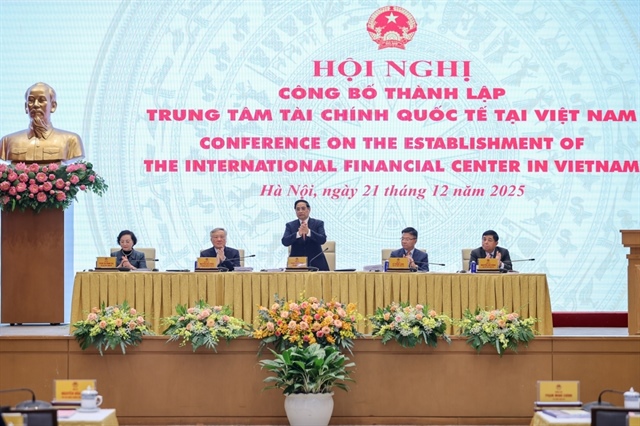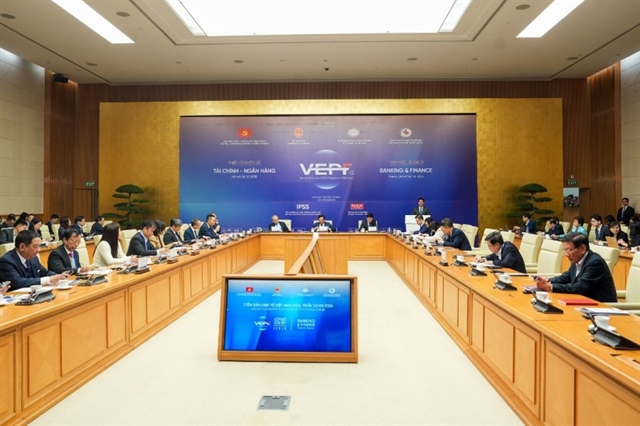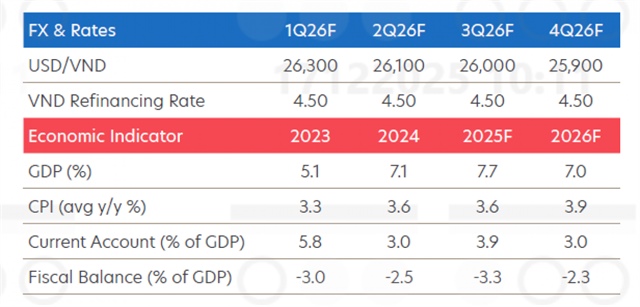VN ponders first cap on interest rates
VN ponders first cap on interest rates
Because of an expected inflation rate of 7.5 per cent by the year-end, the Government has asked the State Bank of Viet Nam to cap and lower lending interest rates in an attempt to helping enterprises access soft bank loans. If approved, it would be the country's first cap on lending interest rates.

The Government's interest-rate controls on loans has raised opinions from the public about its effectiveness.
Since late 2011, the central bank has tightened monetary policy to keep inflation in single digits.
The central bank's deposit interest-rate thresholds and commercial banks' deposit interest-rates remained at levels high enough to reduce inflation.
However, lending interest rates also climbed to high levels, thus restricting access to bank loans.
To help enterprises gain more capital, the government and the central bank said they might put a cap on lending interest rates, particularly now when inflation stands at an acceptable level.
The lending interest rate cap would help the economy recover by lowering interest rates and increasing demand. It would also help enterprises survive, thanks to a reduction in capital-related costs.
However, the lending interest-rate cap would likely have contrary effects.
In particular, if the lending interest rate is capped at a low level and deposit interest rates remain unchanged, commercial banks will increase their interest rates close to the cap on all kinds of loans to ensure profits.
To prevent risks, the banks will give top priority to major customers with high prestige, meaning that small – and medium-d enterprises (SMEs) would have less access to loans. SMEs would even have to pay additional fees to access bank loans.
Thus, enterprises will still not be able to get bank loans and banks would not be able to lend and their credit growth would not increase.
In addition, as the loan and deposit interest rates would be similar, both borrowers and depositors would choose major banks for their transactions, and small banks would suffer. Larger banks have stronger financial capacity and better value-added services.
Deposit interest rates at local banks now average 10 per cent per year, so commercial banks would be difficult to lower their lending interest rates under 15 per cent.
Low-cost retail space
The occupancy rate at many big trade centres has fallen as many companies are taking advantage of cheap rentals to expand their retail businesses and build their trade names.
According to Savills Viet Nam's recent report, in the third quarter of this year, HCM City's total space used for retail activities was about 678,000 sq. metres, a fall of 0.7 per cent compared with the previous quarter.
Meanwhile, CB Richard Ellis (Viet Nam) said that 48 per cent of 168 surveyed shops and trade centres closed, but 30 per cent of them had recently opened.
Because of these changes, the price of retail space had become much cheaper than before.
To take advantage of this opportunity, many retailers have developed their store chains and strengthened the promotion of their products to build brand names.
Passio Coffee, for example, since the beginning of the year, has expanded its store chains in prime locations downtown thanks to a sharp cut in rental of retail space.
At its 100-sqm coffee shop on Nguyen Du Street, the rental price is US$3,000 per month, compared to the previous rate of US$5,000.
As a result, the company opened eight new stores within six months.
Similarly, Viet Fashion Company has opened more shopping centres by taking full use of cheaper rental prices.
The company has signed many contracts to rent spaces for their businesses, with the rental equivalent only half of the price recorded early this year. Its shops are between 600 and 1,000 sq m in .
Although purchasing power has declined, many businesses believe it will pick up in the near future as the recession ends. In addition, sales of some goods in the local market remain good.
Many companies have used their savings on rental prices to diversify and improve their brands.
More people use cards
More Vietnamese consumers are using cards to make payments when shopping as more banks issue debit and credit cards.
In 2008, a mere 2 per cent of consumers used cards to make payments at Nguyen Kim, compared to 98 per cent who paid in cash. This year, the percentage of those using cards has risen to 10 per cent, and even reached 25 per cent when sales promotions took place, according to figures of Nguyen Kim retail company.
The more common use of payment cards is in line with the shift from traditional shopping channels to modern ones.
In 2009, up to 82 per cent of consumers in Viet Nam went shopping at traditional markets and retail shops while only 18 per cent chose to shop at supermarkets and commercial centres. But in 2012, 30 per cent chose the latter.
A 2011 report from Euromonitor (Sai Gon Economic Times) said the number of payment cards issued in Viet Nam was 36.6 million while Singapore had 18.5 million.
However, the number of cardholders' transactions in Singapore was 449,000, 2.5 times higher than the figure in Viet Nam.
Some cards have been issued in Viet Nam but are not being used. In addition, a shortage of credit-card processing equipment has contributed to lower usage.
Euromonitor's report says the country has only 44,000 credit card processing machines, while Singapore has 100,000.
Many Vietnamese consumers also do not understand the advantage of using cards for payments.
Banks should work with companies to encourage people's use of payment cards and help consumers recognise the benefits of using credit cards for payments.
Enterprises should have better sales policies in line with new payment methods to encourage credit card use. In addition, enterprises can achieve stronger sales if they sell their products at lower prices to cardholders. They can also diversify sales channels by selling their products online.
Computer market still sluggish
The sale of laptops at electronics shopping centres in HCM
City continued to decline in the third quarter, despite major promotions.
At Thegioididong and Dienmay.com, which are the largest electronic store chains in the city, the sale of mobile phones, tablet computers and laptops remained stagnant in November.
Sales of laptops alone dropped by eight per cent compared with October although many kinds of laptops that can meet the needs of students and low-income earners were selling for VND5-6million (US$ 250-$300).
The quarterly report on Asia-Pacific from IT market research firm International Data Corporation shows that the computer market in the third quarter in Viet Nam dropped by 4 per cent year-on-year.
Many companies'turnover for one month reduced by half as they sold no desktop computers or laptops.
Computer vendors launched huge sales to attract customers. But overall spending remained low, as concerns about the economy remain, thus affecting short – and medium-term sales.
The government is still tightening spending as the country focuses on inflation reduction and bank restructuring. Meanwhile, high interest rates on loans have also affected enterprises' financial capacity and restricted their spending.
Computer purchases by individuals and companies are not expected to change in the near future, and the market will remain sluggish.
vietnamnews




























